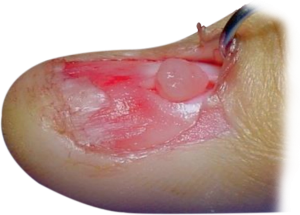Introduction
A glomus tumor is a rare, benign tumor that can develop in the fingers or toes. It is often painful and can cause a range of symptoms that affect hand function. Although glomus tumors are not cancerous, they can still cause significant discomfort and may require medical attention.

What is a Glomus Tumor?
A glomus tumor is a type of tumor that develops from the cells that make up the glomus body, a tiny structure found in the fingers and toes that helps regulate blood flow. Glomus tumors can develop anywhere in the body, but they most commonly occur in the fingers, particularly under the nail bed. There are three types of glomus tumors: solid, glomangioma, and glomangiomyoma.
Causes of Glomus Tumor
The exact cause of glomus tumors is not known, but they are believed to be caused by a mutation in the cells that make up the glomus body. They are also more common in women and tend to develop in people over the age of 30.
Symptoms of Glomus Tumor
The most common symptom of a glomus tumor is pain, which can be severe and often occurs in response to pressure or cold temperatures. Other symptoms may include sensitivity to touch, a bluish or reddish discoloration of the skin, and a feeling of fullness or pressure in the finger.
How are Glomus Tumors Diagnosed?
Diagnosing a glomus tumor typically involves a physical examination, medical history review, and imaging tests such as an MRI or ultrasound.
How are Glomus Tumors Treated?
Treatment options for glomus tumors may include surgery, laser therapy, or medication to relieve pain. The specific treatment approach will depend on the size and location of the tumor, as well as the severity of the symptoms.
Patient Pictures of Glomus
Watch the Video to know more
Meet Our Specialists

Dr. Ish Kumar Garg
Associate Director - Plastic & Microvascular Surgery

Dr. Sundeep Kaur
Associate Director - Plastic & Microvascular Surgery
FAQ’s
Glomus tumors are rare and account for less than 2% of all hand tumors.
No, glomus tumors are not cancerous. They are typically benign and do not spread to other parts of the body.
There is no known way to prevent glomus tumors. However, avoiding trauma to the fingers and toes may reduce the risk of developing a glomus tumor.
Surgery is one of the most common and effective treatment options for glomus tumors. However, other treatment options such as laser therapy or medication to relieve pain may be recommended depending on the size and location of the tumor, as well as the severity of the symptoms.
Recovery time after glomus tumor surgery varies depending on the size and location of the tumor, as well as the type of surgery performed. In general, it can take several weeks to several months for the hand to fully heal and for normal function to be restored. Physical therapy may be recommended to help with recovery. Your doctor will be able to provide more specific information about recovery time based on your individual case.

Leave a Reply